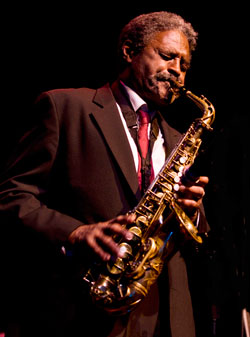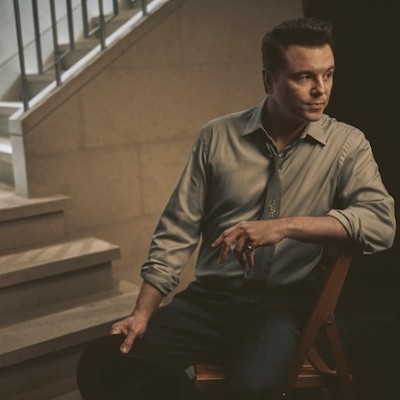Dec 9, 2025 12:28 PM
In Memoriam: Gordon Goodwin, 1954–2025
Gordon Goodwin, an award-winning saxophonist, pianist, bandleader, composer and arranger, died Dec. 8 in Los Angeles.…

Charles McPherson
(Photo: )A memorable night was in store on June 7, the first evening of a weeklong bebop master class at New York’s Jazz Standard, courtesy of the Charles McPherson Quintet.
The great alto saxophonist McPherson was backed by a strong rhythm section with pianist Jeb Patton, bassist Ray Drummond and Billy Drummond on drums. And with trumpeter Brian Lynch, there was perhaps potential for another great musical marriage in jazz, in the vein of Charlie Parker and Dizzy Gillespie. In fact, the performance was a bit of a reunion for McPherson and Lynch. Before he would go on to work with Eddie Palmieri and Art Blakey and the Jazz Messengers, Lynch actually started out performing with McPherson in the early 1980s while he lived in San Diego. Throughout much of the Jazz Standard set, McPherson and Lynch created an ebb and flow, a back-and-forth of hot and cool sounds, if you will, that almost seemed too forward-thinking even for today’s music scene. And that’s chiefly because of McPherson’s original compositions. Like his playing, McPherson’s music has been touched by both the blues from his Midwest upbringing and the modern jazz scene while living in New York, notably from the years he spent working with the great Charles Mingus. And like much of Mingus’ body of work, McPherson’s compositions have a pulse and a soul to them.
“Song Of The Sphinx” was undoubtedly inspired by Mingus as Ray Drummond’s bass line punctuated the opening of the piece. After the rhythm section came in with its samba-like grooves, Lynch’s fluid, high notes pierced right through while McPherson explored the tonal possibilities as he started off soft and low, then gradating to a higher (but never loud) pitch, making it much more lively. On McPherson’s original tune “The Journey,” that playfulness continued, but this time, it was shared between him and Lynch as both horns teetered back-and-forth again between a tight unison and a lyrical round in which McPherson’s edgy yet cool saxophone began a half a measure after Lynch’s hard-bop flourishes. McPherson was not only a noticeable leader of this tight ensemble, but he allowed each of his bandmates to shine during their respective improvisations.
DownBeat recently sat down with McPherson to discuss his illustrious career (which began in 1960 with Mingus), the impact of growing up in the Midwest on his overall sound and what lies ahead for the saxophonist.
When did you first decide to take up the saxophone?
When I was a kid, I grew up in Joplin, Mo. When I was 6 or 7 years old, bands would come through Joplin and play in the summertime and I would see them playing in this park. I was enamored of the shiny brass instruments when I was really a little kid. And I particularly liked the way the saxophone looked physically and I also liked the way it sounded. I didn’t really start playing until I moved to Detroit and I started on the saxophone when I was about 13. I think after about a year or two, I knew I wanted to play music and not do anything else. I knew that pretty early on. And saxophone, I had already chosen that instrument. And I knew I wanted to play jazz. I had heard jazz before, so I liked the way it sounded and that was pretty much it. So I would say at 14, I pretty much knew I wanted to do that.
I recently sat down with another Detroit-bred musician, jazz violinist Regina Carter. How did growing up in Detroit impact you as a jazz musician?
At that time, it was the late 1950s. Detroit was a vibrant city and the [influx] of Japanese and German cars hadn’t kicked in yet, so the automobile industry was still happening. The town was still economically secure and people were working. Those were the days when there was less to keep them inside. People came out and fraternized more. And there were a lot of clubs and a lot of places to play. This was just a little bit before Motown. I missed that because I left when Motown really kicked off. I didn’t really get involved with that and I’m glad because that probably would have been seducing for me to stay there. In those days, you would go to New York if you thought you were ready for the so-called big time [laughs]. When Motown came on, it supplied a lot of work for the local musicians, including jazz musicians. There were guys with families who didn’t want to take a chance and jump in deep water, you know, and here’s Motown. So a lot of people stayed because it was secure and it was there and you didn’t have to leave town. I left just before that and that’s the way things worked out. But Detroit was an interesting city at that point—of course it’s quite different now. And I don’t think there are as many places to play as there was when I was growing up there. And even before me, from what I understand from people a lot older than I, the 1940s was when it was really happening. The 1950s was OK for there were still some happenings, but by the 1960s it was starting to dwindle. And that was kind of it. That’s when Motown started happening and it was good for them.
Who were some of your musical idols growing up?
Before I discovered bebop—Charlie Parker, Dizzy Gillespie and those people—I was more into rhythm and blues, and I knew about Duke Ellington, Count Basie, Johnny Hodges, who worked with Ellington, a real great saxophone player. I kind of knew about those people and I thought that was pretty much all it was. And then I discovered Charlie Parker, Miles Davis and that whole genre of so-called bebop as it was called in those days. When I heard that, it immediately spoke to me. I didn’t need to be propagandized. For whatever reason, it spoke and I was just a kid. I just knew, I understood what that meant, it made sense and it was like, “Yeah, that’s the way it should go.” And then I found out that this was a particular genre of music and there were people who played this particular style. In those days, it was also called progressive jazz or modern jazz or bebop. It’s the movement in jazz right after swing and big band. Then I found out that there’s a category and it’s called bebop, modern jazz, whatever, and people play it and then I found out who they were. And then I started listening to those records and serendipity occurred. I was fortunate in that one of the clubs in Detroit featured that particular kind of music. It was right down the street from my house. So it was a done deal. I had seen that club before. It was the jazz musicians’ club in Detroit, and it was the place, really. I’d seen people walk into the club when I was a little kid playing in my front yard. I would see people going to it and wonder, “Where are these people going?” I would see these people walk down the street at 9 or 10 years old and wondering where are they going and of course someone says, “Well, they’re going to that bar down there.”
At 14 or 15 years old, I had discovered the music, and now I realized that the music I’m into is featured in that club that I’ve known about for years. Then I just start going down and standing out in front of the club and listening because I’m too young to get in—you had to be 21. That’s when I met some of the great Detroit musicians who were still in town at that time, and I started studying with one of the piano players who worked in this club. His name is Barry Harris, a pretty well-known New York pianist and a teacher. I started studying with him and he just happened to live around the corner—five minutes walking distance—so my whole life was set up. I started with him at 15 and by 19, I was able to play professionally.

Goodwin was one of the most acclaimed, successful and influential jazz musicians of his generation.
Dec 9, 2025 12:28 PM
Gordon Goodwin, an award-winning saxophonist, pianist, bandleader, composer and arranger, died Dec. 8 in Los Angeles.…

Flea has returned to his first instrument — the trumpet — and assembled a dream band of jazz musicians to record a new album.
Dec 2, 2025 2:01 AM
After a nearly five-decade career as one of his generation’s defining rock bassists, Flea has returned to his first…

“It’s a pleasure and an honor to interpret the music of Oscar Peterson in his native city,” said Jim Doxas in regard to celebrating the Canadian legend. “He traveled the world, but never forgot Montreal.”
Nov 18, 2025 12:16 PM
In the pantheon of jazz luminaries, few shine as brightly, or swing as hard, as Oscar Peterson. A century ago, a…

Dec 11, 2025 11:00 AM
DownBeat presents a complete list of the 4-, 4½- and 5-star albums from 2025 in one convenient package. It’s a great…

Seth MacFarlane takes a turn from his television and film career to sing arrangements made for Frank Sinatra, but never recorded.
Nov 18, 2025 12:04 PM
“I’m not gonna lie to you — I don’t know why I thought this was about The Naked Gun, but I’m happy it’s…